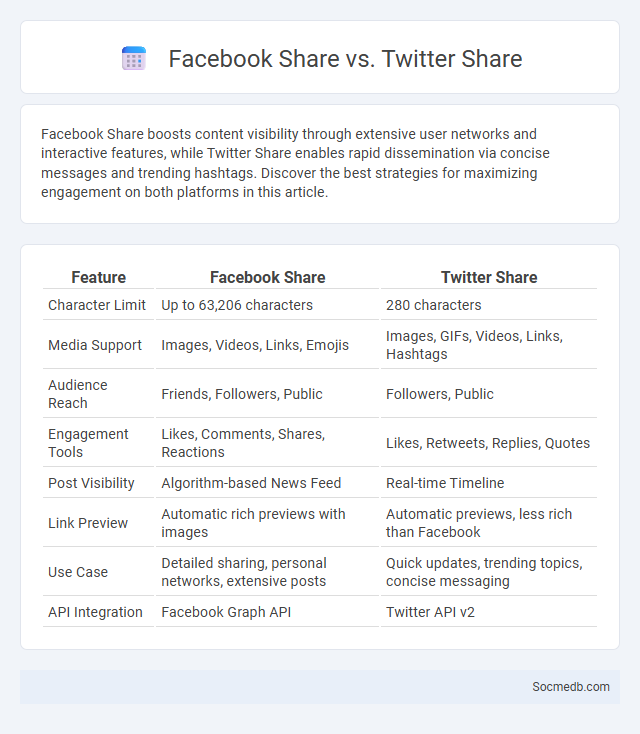
Photo illustration: Facebook Share vs Twitter Share
Facebook Share boosts content visibility through extensive user networks and interactive features, while Twitter Share enables rapid dissemination via concise messages and trending hashtags. Discover the best strategies for maximizing engagement on both platforms in this article.
Table of Comparison
| Feature | Facebook Share | Twitter Share |
|---|---|---|
| Character Limit | Up to 63,206 characters | 280 characters |
| Media Support | Images, Videos, Links, Emojis | Images, GIFs, Videos, Links, Hashtags |
| Audience Reach | Friends, Followers, Public | Followers, Public |
| Engagement Tools | Likes, Comments, Shares, Reactions | Likes, Retweets, Replies, Quotes |
| Post Visibility | Algorithm-based News Feed | Real-time Timeline |
| Link Preview | Automatic rich previews with images | Automatic previews, less rich than Facebook |
| Use Case | Detailed sharing, personal networks, extensive posts | Quick updates, trending topics, concise messaging |
| API Integration | Facebook Graph API | Twitter API v2 |
Understanding Social Media Sharing: Facebook vs Twitter
Facebook excels in sharing detailed posts with rich media, allowing you to connect deeply with your audience through images, videos, and longer text formats. Twitter prioritizes brevity and immediacy, making it ideal for real-time updates and concise messages limited to 280 characters. Understanding these platform-specific sharing behaviors helps tailor your social media strategy to maximize engagement and reach.
The Basics: What Does “Share” Mean on Social Platforms?
The term "share" on social media platforms refers to the action of reposting or distributing content from one user to their own network, enhancing visibility and engagement. Sharing enables users to amplify messages, opinions, or media such as photos, videos, and articles across platforms like Facebook, Instagram, Twitter, and LinkedIn. This functionality drives content virality, increases user interaction, and expands audience reach effectively.
Facebook Share: Features and User Engagement
Facebook Share enables users to effortlessly distribute content across their network, enhancing visibility and reach for posts, links, and multimedia. By integrating share buttons on websites, you can boost user engagement and drive traffic directly to your page. The feature supports rich previews and customizable messages, encouraging more interactions and social sharing activity.
Twitter Share: Retweets and Quote Tweets Explained
Twitter engagement metrics such as Retweets and Quote Tweets are essential for amplifying content reach and fostering user interaction. Retweets enable users to share original tweets with their followers, increasing visibility without modifying the content. Quote Tweets allow users to add their commentary while sharing, combining original message amplification with personalized context for enhanced audience engagement.
Key Differences in Sharing Mechanisms
Social media platforms differ significantly in their sharing mechanisms, with Facebook emphasizing a versatile feed that supports text, images, videos, and live broadcasts, while Twitter prioritizes real-time microblogging limited to concise posts called tweets. Instagram focuses on visual content sharing through photos, stories, and reels, optimized for mobile engagement, whereas LinkedIn targets professional networking by enabling article sharing, business updates, and industry news. These distinct sharing formats influence user interaction, content visibility, and engagement metrics across platforms.
Audience Reach: Facebook Share vs Twitter Share
Facebook share typically results in a broader audience reach due to its larger global user base exceeding 2.9 billion monthly active users, compared to Twitter's approximately 450 million users. Facebook's algorithm prioritizes shared content in News Feeds, often increasing visibility and engagement, whereas Twitter's timeline emphasizes real-time updates, leading to faster but shorter-lived exposure. Brands aiming for extensive demographic targeting often prefer Facebook shares, while Twitter shares are favored for real-time conversations and trending topics.
Content Virality: Which Platform Maximizes Shares?
TikTok leads in content virality due to its sophisticated algorithm that promotes engaging videos quickly across user feeds, significantly increasing share rates. Instagram Reels and YouTube Shorts also drive high shareability through their short-form video formats, appealing to younger demographics. Facebook's extensive user base supports viral content, but its share rates are often lower compared to TikTok's rapid engagement cycles.
Privacy and Control: Sharing on Facebook vs Twitter
Your privacy and control over personal information differ significantly between Facebook and Twitter. Facebook offers granular privacy settings that allow you to customize who can see your posts, manage friend lists, and control data sharing with third-party apps. Twitter, while more public by design, enables you to protect your tweets, limit interactions through blocking or muting, and control discoverability, but generally provides fewer options for granular audience segmentation.
Analytics: Tracking Engagement from Shares
Tracking engagement from shares on social media provides valuable insights into how your content resonates with the audience, revealing patterns of interaction beyond mere likes or comments. Analytics tools measure metrics such as share counts, reach expansion, and referral traffic generated from shared posts, allowing you to identify content that drives organic growth and brand advocacy. Understanding these data helps optimize your social media strategy to enhance visibility and foster deeper user connections.
Best Practices for Encouraging Shares on Each Platform
Crafting engaging, platform-specific content boosts your social media shares effectively by aligning with the unique audience behaviors on Facebook, Instagram, Twitter, LinkedIn, and TikTok. Utilizing eye-catching visuals, compelling headlines, and interactive features like polls or hashtags maximizes user interaction and shareability. You can enhance your reach by tailoring messages to each platform's algorithm and encouraging authentic engagement through calls-to-action that resonate with your followers' interests.
 socmedb.com
socmedb.com